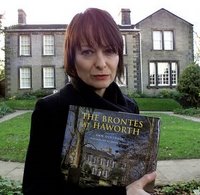 The Bradford Telegraph & Argus
The Bradford Telegraph & Argus publishes an article about the new Ann Dinsdale book
The Brontës of Haworth:
A new, lavishly illustrated book about the life and times of the Brontes will portray the harshness of nineteenth century Haworth life. (...)
She said the book showed how difficult life was in the time of the Brontes, with the average life expectancy of villagers in 1850 less than 26 years.
She said: "This does change the way in which we view the Brontes.
"People have this idea that they were very sickly women, but when you look at what life was like in Haworth, you realise they actually did quite well." (...)
She said: "They liked it so much they asked if we'd be interested in doing a book. I've been working at the parsonage for 17 years so I'm quite familiar with the subject.
"I've got a good idea of the kind of questions people usually ask about the Brontes, so I've tried to answer a lot of them in the book."
She said she only saw the finished version of the book last month and was delighted with it.
Ann Dinsdale said: "I'm thrilled really. There are a lot of new images produced specially for the book, including some lovely landscape photos."
She added she felt privileged to have worked with Mr Warner.
Mr Warner is an experienced photographer and video artist. He has previously illustrated three National Trail Guides and is the author of Discovering West Yorkshire.
He has also exhibited his work. Last year he projected a set of moorland-inspired images onto the façade of the parsonage museum. (Miran Rahman)
The
New York Magazine interviews Emma Thompson. The actress confesses that she is not only a Janeite, but also a Brontëite:
Have you ever identified with a character to an unusual degree?
I tend to identify with characters in books by Austen and Eliot and the Brontës. Oddly enough, I’m probably still vaguely Victorian. Moderns are just different. As a child, my mind latched onto a kind of Victorian morality, which I don’t necessarily think did me that much good, to be honest. It’s not ideal. I suppose there’s something spinal, there’s something that lives in your ganglia, that connects you to past moral models, and it’s very difficult to unhook yourself from them. (...)
At Cambridge, you became a comedian and a feminist.
It was an incredible moment for me. At college it was structuralism and Bakhtin and all that lot, and I found it all very masculine and backstab-y … There is no one more vicious than an academic. So my seminal moment in university, having grown up reading the Victorian female novelists, was discovering Gilbert and Gubar’s book The Madwoman in the Attic, which is about Victorian female writers and the disguises they took on in order to express what they wanted to express. That completely changed my life.
The
Brontë Parsonage Blog publishes an interesting post about a recent booklet written by Norman E. Penty on the life of William Smith Williams (1800-1875), the literary editor of Smith & Elder and frequent correspondent of Charlotte Brontë.
Charlotte Brontë may have remained in obscurity if it had not been for the faith, foresight and fortitude of William Smith Williams, the literary editor of Smith Elder who first recognised her talent when, using the pseudonym Currer Bell, and after a number of rejections, she forlornly sent them a copy of The Professor. Even though this manuscript was initially rejected it was done in such a positive and encouraging manner that Charlotte shortly sent Williams a draft of Jane Eyre which was soon published to great acclaim. (...)
My research into discovering more about this fascinating man concentrated on parish records, census returns, and wills, etc., all of which enabled me to trace the origins of his family back to 1690 in Oxfordshire; (read more)
The booklet was first published as
The discovery of Charlotte Bronte : William Smith Williams 1800-75 : a genealogical quest, Family history tracts, vol. 249
Finally, we highlight this
Wycoller Walk entry on this blog. Basically because we made this walk some years ago and we enjoyed it very much:
Wycoller! On the Bronte Trail (...) Wycoller is a very attractive Lancashire Village. The, now ruined, hall was possibly the inspiration for one of the buildings mentioned in Jane Eyre.
Categories: Books, In the News, Brontëites, Brontëana, Charlotte Brontë









0 comments:
Post a Comment